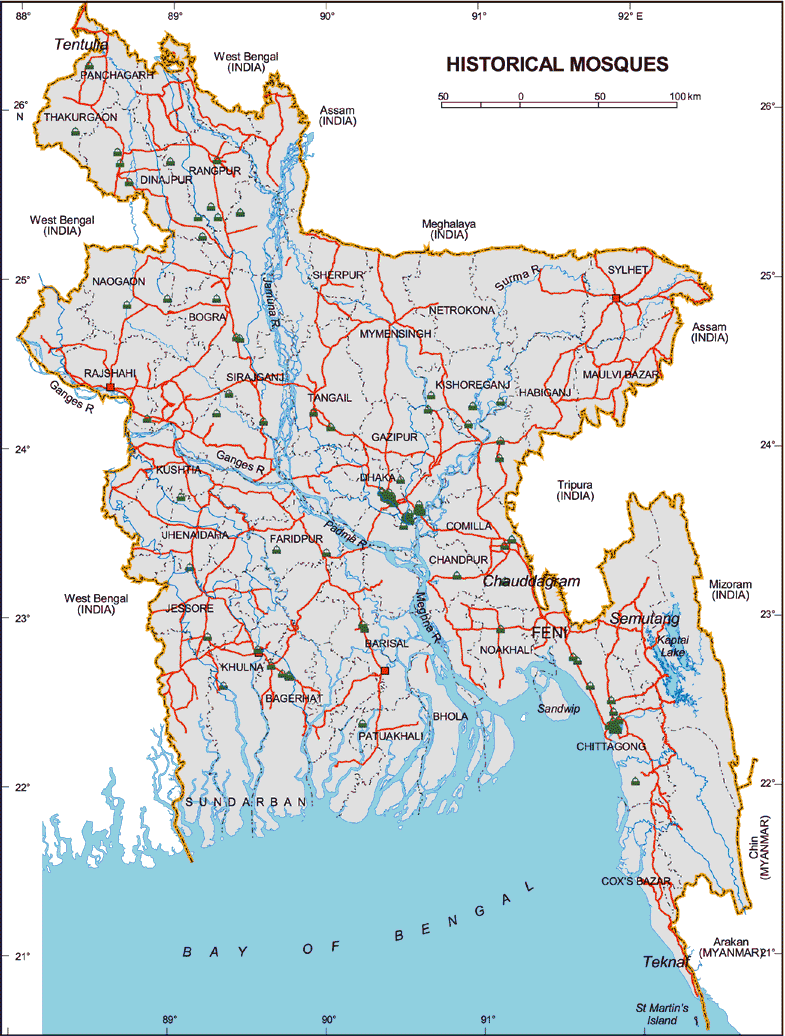Info
Some Historical Mosques of Bangladesh
Shat Gombuj Masjid
The Sixty Pillar Mosque (the Shat Gambuj), in Bagerhat in south Bangladesh, on the eastern bank of a sweet water tank or pond (the takur dighi) is one of the oldest mosques in the country and is described as "historic mosque representing the Golden Era of Muslim Bengal".It is laid is over an area of 160 feet (49 m) by 108 feet (33 m).The mosque is unique in that it has 60 pillars that support 77 exquisitely curved "low squat domes" that have worn away over time; it has seven central domes that are four-sided and built in Bengali style.It was established in 1440 by Khan Jahan Ali.
It was used for prayers, as an assembly hall and madrasa (an Islamic school). Seventy seven domes are over the roof and four smaller ones at the four corners are towers (the towers were used to call the faithfuls to attend prayers). The large prayer hall has 11 arched doorways on the east and 7 each on the north and south which provide ventilation and light to the hall. There are 7 longitudinal aisles and 11 deep bays in the midst of slim columns made of stone. These columns support the curving arches that are overlaid by the domes. The west wall in the interior has eleven mihrabs that are decorated with stonework and terracotta and the flooring is brickwork. The walls and the mihrabs were affected by sulphates. Most of the damage has been rectified. The arches are 6 feet (1.8 m) thick with a slight taper over the hollow and round walls. The mosque also functioned as the court of Khan Jahan Ali. It now attracts a large number of tourists and visitors. The mosque is decorated mostly with terracotta and bricks.
Nine dome Mosque
The Nine Dome Mosque is located to the west of the takur dighi tank and built in the 15th century, it is close to Khan Jahan Ali's Tomb. Its western wall conventionally faces west towards Mecca, where the mihrab is inset on the western wall; terra cotta floral scrolls and flower motifs are the decorations seen around the mihrab. Circular towers are provided in the four corners. The walls of the mosque support a large central dome which has eight smaller domes around it. This structure was also affected by sulphates. It has been since substantially restored. Close to this mosque are the Zinda Pir Mosque and mazar (tomb), which are in ruins.
Singara Mosque
The Singara Mosque is across the road from the Saith Gumbaz Mosque on its southeastern side. It has a single dome which is heavily built and a wide dome. In the typical style of the Khan Jahan Ali, the dome is supported on thick walls and topped with a cambered cornice. The Bigi Begni Mosque and the Chuna Khola Mosque are also of single dome type but much larger in size compared to the Singara Mosque. Last reported, the mosque was in a state of decay and renovation works were envisaged.
Ronvijoypur Mosque
The Ronvijoypur Mosque has the largest dome in Bangladesh. It is of 11 metres (36 ft) width supported by arches and pendentives. The corners have tapering circular turrets while the external cornice has a slight curve. The mosque's interior is plain. However the main mihrabs have decorations of floral patterns. It is located on the opposite side of the Khan Jehan Mausoleum, on the Khulna Bagerhat road. It is built according to Khan Jehan style of architecture. It has been renovated many times in the past during the 1960s and 70s. However, it needs further repair work to prevent dampness inside the tomb, and also to the brickwork on the exterior surfaces.
The Chunakhola Mosque
The Chuna Khola Mosque, built in the 15th century, is located in the midst of rice fields in the village of Chuna Khola (named after the limestone extraction that was in vogue here in the past). It has been identified as representing a transition from the Khan Jehan style monuments. It is a 7.7 metres (25 ft) square building with 2.24 metres (7 ft 4 in) thick walls. It has three entrances on the east and one each on the northern and southern sides also. It has three mihrabs with the central mihrab being the largest in size and projecting outwards. It has a hemispherical dome with frontal arches. There are also squinches and half domes. It is distinctly different from the Khan Jehan style mosque in its exterior decorations, particularly the east façade, which depicts four rectangular panels bordered by foliated scrolls with merlons having plant motifs. It has four turrets with curved cornices. The brick walls, in particular, were damaged due to sulphate effect. It was renovated in the 1980s according to guidelines set by UNESCO.
Six-Domed Mosque
The Six-Domed Mosque (also called the Rezakodha Masjid), built in the 15th century near thakur dighi pond, had six domes supported by stone columns. Protected under the Antiquities Act, the main mihrab displayed a chain and bell design. However, since it was all in ruins, a new building had been built, which has since been removed and the old ruins retained.
Source: Wikipedia.

